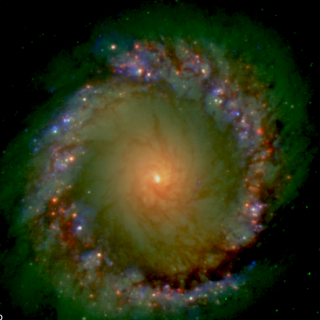Bibcode
Müller-Sánchez, F.; Malkan, M. A.; Elitzur, M.; Davies, R. I.; Mezcua, M.; Prieto, M. A.
Bibliographical reference
The Astrophysical Journal Letters, Volume 763, Issue 1, article id. L1, 6 pp. (2013).
Advertised on:
1
2013
Citations
39
Refereed citations
38
Description
We present observations of the molecular gas in the nuclear environment
of three prototypical low-luminosity active galactic nuclei (LLAGNs),
based on VLT/SINFONI AO-assisted integral-field spectroscopy of
H2 1-0 S(1) emission at angular resolutions of ~0.''17. On
scales of 50-150 pc, the spatial distribution and kinematics of the
molecular gas are consistent with a rotating thin disk, where the ratio
of rotation (V) to dispersion (σ) exceeds unity. However, in the
central 50 pc, the observations reveal a geometrically and optically
thick structure of molecular gas (V/σ < 1 and N H
> 1023 cm–2) that is likely to be
associated with the outer extent of any smaller scale obscuring
structure. In contrast to Seyfert galaxies, the molecular gas in LLAGNs
has a V/σ < 1 over an area that is ~9 times smaller and column
densities that are on average ~3 times smaller. We interpret these
results as evidence for a gradual disappearance of the nuclear obscuring
structure. While a disk wind may not be able to maintain a thick
rotating structure at these luminosities, inflow of material into the
nuclear region could provide sufficient energy to sustain it. In this
context, LLAGNs may represent the final phase of accretion in current
theories of torus evolution. While the inflow rate is considerable
during the Seyfert phase, it is slowly decreasing, and the collisional
disk is gradually transitioning to become geometrically thin.
Furthermore, the nuclear region of these LLAGNs is dominated by
intermediate-age/old stellar populations (with little or no ongoing star
formation), consistent with a late stage of evolution.
Based on observations at the European Southern Observatory VLT
(082.B-0709 and 084.B-0568).
Related projects

The Central PARSEC of Galaxies using High Spatial Resolution Techniques
PARSEC is a multi-wavelength investigation of the central PARSEC of the nearest galaxies. We work on black-hole accretion and its most energetic manifestations: jets and hot spots, and on its circumnuclear environment conditions for star formation. We resort to the highest available angular resolution observations from gamma-rays to the centimetre
Almudena
Prieto Escudero